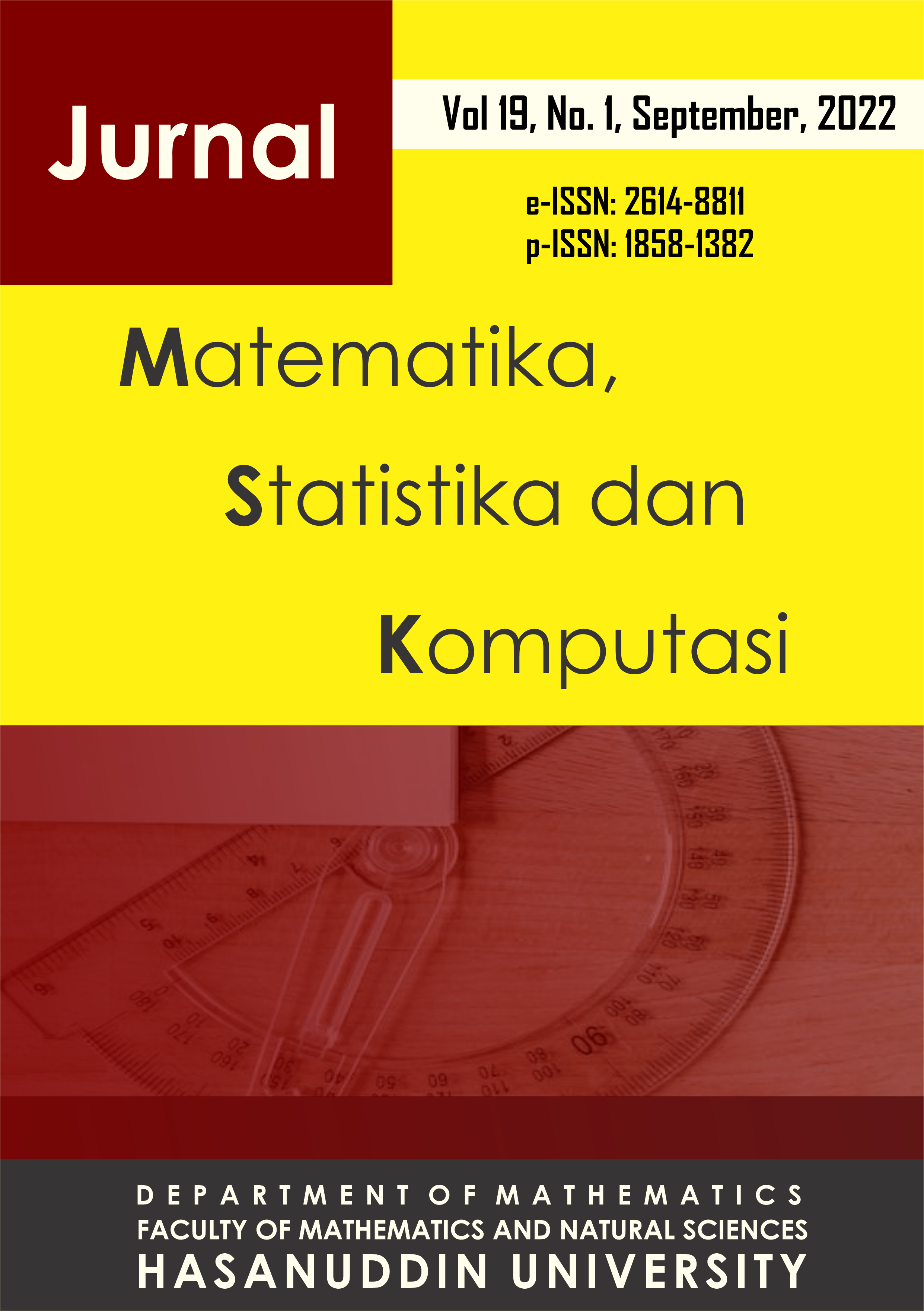Identification of Factors that Influence Stunting Cases in South Sulawesi using Geographically Weighted Regression Modeling
DOI:
https://doi.org/10.20956/j.v19i1.21617Keywords:
children, geographically weighted regression, stuntingAbstract
In Indonesia, nearly seven million children under five are stunted and throughout the world, Indonesia is the country with the fifth-highest stunting prevalence. South Sulawesi ranks fourth with a high stunting potential in Indonesia. Stunting is caused by multi-dimensional factors and not only due to malnutrition experienced by pregnant women and children under five. In more detail, several factors that cause stunting are the effects of poor care, the lack of household/family access to nutritious food, and the lack of access to clean water and sanitation. In addition to maternal characteristics and parenting, the problem of stunting is also influenced by environmental factors and geographical conditions (population density, climatic conditions, and inadequate sanitation) so the spatial analysis is important to do in overcoming this problem. In spatial data, often observations at a location (space) depend on observations at other locations that are nearby (neighboring). By using Geographically Weighted Regression (GWR) obtained variables that affect the prevalence of stunting in South Sulawesi Province, including the percentage of babies receiving vitamin A intake, the percentage of babies receiving exclusive breastfeeding, the percentage of babies receiving health care, the percentage of malnourished children under five, the percentage short toddlers, the percentage of infants receiving DPT-HB-Hib, Measles and BCG immunizations. for the GWR model is 81.32% and based on variables that are significant to the prevalence of stunting in South Sulawesi Province, three clusters are formed.
References
Aidi, N.M., Fitrah, E., and Siswanto., 2018. Analysis of Factors Affecting the Number of Poor People in Indonesia Using Geographycally Weighted Regression. International Journal Scientific Research in Science Engineering Technology (IJSRSET), Vol.4, No.4, 1538-1553.
Badan Perencanaan dan Pembangunan Nasional. 2018. Pedoman Pelaksanaan Intervensi Penurunan Stunting Terintegrasi di Kabupaten/Kota. Jakarta (ID): BAPPENAS.
Chasco, C., García, R. and Vicens, O., 2007. Modeling spatial variations in household disposable income with geographically weighted regression. MPRA Paper No. 1682.
Dinas Kesehatan Profinsi Sulawesi Selatan. 2013. Profil Kesehatan Provinsi Sulawesi Selatan. Makassar.
Dinas Kesehatan Profinsi Sulawesi Selatan. 2018. Profil Kesehatan Provinsi Sulawesi Selatan. Makassar.
Fotheringham, A.S., Brunsdon, C. and Charlton, M. 2003. Geographically weighted regression: the analysis of spatially varying relationships. John Wiley & Sons.
Gwarda, K.L. 2018. Geographically Weighted Regression in the Analysis of Unemployment in Poland. International Journal of Geo-Information. Vol. 7. No. 17, 1-16.
Leong, Y.Y. and Yue, J.C. 2017. A Modifiaction to Geographically Weighted Regression. International Journal of Health Geographics. Vol. 16, No. 11, 1-18.
Mahdy, I. F., 2020. Pemodelan Jumlah Kasus Covid-19 Di Jawa Barat Menggunakan Geographically Weighted Regression. In Seminar Nasional Official Statistics, Vol. 2020, No. 1, 138-145.
Kementerian Kesehatan Republik Indonesia. 2019. Riset Kesehatan Dasar Dalam Angka (RISKESDAS 2018) Provinsi Sulawesi Selatan. Jakarta (ID): Lembaga Penerbitan Badan Litbangkes.
Picauly, I. and Toy, S.M., 2013. Analisis Determinan Dan Pengaruh Stunting Terhadap Prestasi Belajar Anak Sekolah Di Kupang Dan Sumba Timur, NTT. Jurnal gizi dan pangan, Vol.8, No.1, 55-62.
Sukarsa, I. K. G., and Kencana, I. P. E. N., 2019. Penerapan Metode Geographically Weighted Regression (GWR) Pada Kasus Penyakit Pneumonia Di Provinsi Jawa Timur. E-Jurnal Matematika, Vol. 8, No.1, 27-34.
Zhao, H., Ren, Z., and Tan, J., 2018. The spatial patterns of land surface temperature and its impact factors: spatial non-stationarity and scale effects based on a geographically-weighted regression model. Sustainability, Vol. 10, No. 7, 2242.
Downloads
Published
How to Cite
Issue
Section
License
Copyright (c) 2022 Author and publisher

This work is licensed under a Creative Commons Attribution 4.0 International License.

This work is licensed under a Creative Commons Attribution 4.0 International License.
Jurnal Matematika, Statistika dan Komputasi is an Open Access journal, all articles are distributed under the terms of the Creative Commons Attribution License, allowing third parties to copy and redistribute the material in any medium or format, transform, and build upon the material, provided the original work is properly cited and states its license. This license allows authors and readers to use all articles, data sets, graphics and appendices in data mining applications, search engines, web sites, blogs and other platforms by providing appropriate reference.







